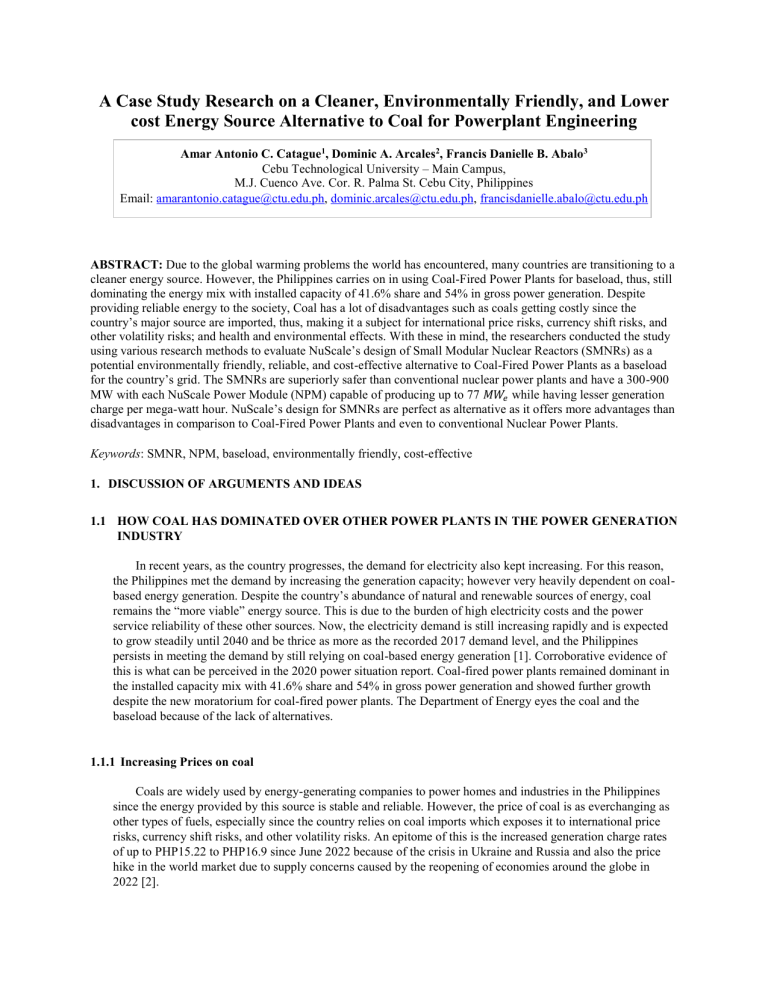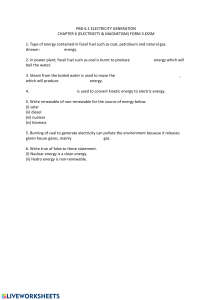A-Case-Study-Research-on-a-Cleaner-Environmentally-Friendly-and-Lower-cost-Energy-Source-Alternative-to-Coal-for-Powerplant-Engineering-15
advertisement

A Case Study Research on a Cleaner, Environmentally Friendly, and Lower cost Energy Source Alternative to Coal for Powerplant Engineering Amar Antonio C. Catague1, Dominic A. Arcales2, Francis Danielle B. Abalo3 Cebu Technological University – Main Campus, M.J. Cuenco Ave. Cor. R. Palma St. Cebu City, Philippines Email: amarantonio.catague@ctu.edu.ph, dominic.arcales@ctu.edu.ph, francisdanielle.abalo@ctu.edu.ph ABSTRACT: Due to the global warming problems the world has encountered, many countries are transitioning to a cleaner energy source. However, the Philippines carries on in using Coal-Fired Power Plants for baseload, thus, still dominating the energy mix with installed capacity of 41.6% share and 54% in gross power generation. Despite providing reliable energy to the society, Coal has a lot of disadvantages such as coals getting costly since the country’s major source are imported, thus, making it a subject for international price risks, currency shift risks, and other volatility risks; and health and environmental effects. With these in mind, the researchers conducted the study using various research methods to evaluate NuScale’s design of Small Modular Nuclear Reactors (SMNRs) as a potential environmentally friendly, reliable, and cost-effective alternative to Coal-Fired Power Plants as a baseload for the country’s grid. The SMNRs are superiorly safer than conventional nuclear power plants and have a 300-900 MW with each NuScale Power Module (NPM) capable of producing up to 77 𝑀𝑊𝑒 while having lesser generation charge per mega-watt hour. NuScale’s design for SMNRs are perfect as alternative as it offers more advantages than disadvantages in comparison to Coal-Fired Power Plants and even to conventional Nuclear Power Plants. Keywords: SMNR, NPM, baseload, environmentally friendly, cost-effective 1. DISCUSSION OF ARGUMENTS AND IDEAS 1.1 HOW COAL HAS DOMINATED OVER OTHER POWER PLANTS IN THE POWER GENERATION INDUSTRY In recent years, as the country progresses, the demand for electricity also kept increasing. For this reason, the Philippines met the demand by increasing the generation capacity; however very heavily dependent on coalbased energy generation. Despite the country’s abundance of natural and renewable sources of energy, coal remains the “more viable” energy source. This is due to the burden of high electricity costs and the power service reliability of these other sources. Now, the electricity demand is still increasing rapidly and is expected to grow steadily until 2040 and be thrice as more as the recorded 2017 demand level, and the Philippines persists in meeting the demand by still relying on coal-based energy generation [1]. Corroborative evidence of this is what can be perceived in the 2020 power situation report. Coal-fired power plants remained dominant in the installed capacity mix with 41.6% share and 54% in gross power generation and showed further growth despite the new moratorium for coal-fired power plants. The Department of Energy eyes the coal and the baseload because of the lack of alternatives. 1.1.1 Increasing Prices on coal Coals are widely used by energy-generating companies to power homes and industries in the Philippines since the energy provided by this source is stable and reliable. However, the price of coal is as everchanging as other types of fuels, especially since the country relies on coal imports which exposes it to international price risks, currency shift risks, and other volatility risks. An epitome of this is the increased generation charge rates of up to PHP15.22 to PHP16.9 since June 2022 because of the crisis in Ukraine and Russia and also the price hike in the world market due to supply concerns caused by the reopening of economies around the globe in 2022 [2]. . 1.1.2 Increasing Generation Cost of coal The Demand for Coal has already hit the 400$ or approximately 20,000 pesos per metric ton mark, as coal consumption has been increasing by four times its price since January 2010, which remained at that range until march 2021 [3]. And by which according to The Department of Energy here in the Philippines, the Philippine Independent Power Producers Association (PIPPA) indicated an increase in rates per kilowatt-hour after coal prices reached 446$(23,000 Php) per metric ton [4]. Prices for Natural gas for power generation have been rising due to the war in Ukraine, by which some European countries are switching to coal which makes the demand higher and drives the prices higher. With higher prices, the cost of Coal generation has increased by four times from the prices in 2010 - to march 2021. 1.1.3 Accumulated Damage on Coal Generation. With over 41.6% share in the power energy mix and 54% in gross power generation, Coal generation has maintained dominance in the power industry; however, Coal generation has caused damages over lengths of a period of time in its operation. It was having caused air pollution, which comprises a number of different heavy metals as well as mercury, lead, sulfur dioxide, nitrogen oxides, and particulates [5]. The negative effects on health might include everything from asthma and respiratory issues to brain damage, heart issues, cancer, neurological diseases, and early death. This also impacts global warming, which includes drought, flooding, sea level rise, and extreme weather [6]. With deaths either caused by accidents on the operation or air pollution reaching 32.72 deaths for brown coal and 24.62 for ordinary coal [7] 1.2 INTRODUCTION TO APPLICATION OF SMALL MODULAR NUCLEAR REACTOR (SMNR) AS AN ALTERNATIVE FOR COAL As the world progresses in the utilization of Nuclear Energy, an idea was made by a company by ‘thinking small’. Quite literally, the company was able to realize a nuclear reactor that is modular and smaller than conventional nuclear reactors. NuScale, a company founded in 2007, pivoted the creation and utilization of a small and modular nuclear reactor that only takes up 1% of the space of the conventional reactor, which they call the Small Modular Nuclear Reactor (SMNR). Technically, the first nuclear reactors made were small, but that was simply because that is the limit of the emerging technology, whereas SMNRs are small to achieve objectives such as generating emission-free electricity to remote locations. Compared to a typical nuclear plant of 1000 MW, SMNR has a capacity of 300-900 MW. SMRs use NuScale’s Power Module (NPM) which is capable of generating 77 MW of electricity by making use of a more compact, secure, and scalable pressurized water reactor technology [8] [9]. In 2022, the U.S Nuclear Regulatory Commission issued a rule certifying NuScale’s SMNR as the design has met all the applicable safety requirements 1.2.1 How is it Compared to Coal Generation? Coal-Fired Power Plant and Small Modular Nuclear Reactor have a lot of differences as expounded in the previous discussions. While it is true that Coal-Fired Power Plants are used because of their power service reliability, SMNR doesn’t really fall behind as it is also a baseload power plant capable of operating 24/7. SMNR also offers more edge than Coal-Fired Power Plants; despite being a ‘nuclear reactor’, SMNR doesn’t use large and complex mechanical systems found in conventional/typical nuclear power plants which is why it is relatively less expensive to build, and from this simplification together with safeguard designs, the SMNR is impervious to meltdowns [9]. Also, compared to Coal-Fired Power Plant, SMNR has a small design making it applicable to remote locations that have little to no connectivity to the primary power grid and also widening its market reach. The reactor also generates emission-free electricity – making the plant a safer yet scalable and more economical alternative to coal [8]. 2. ANALYSIS In The Current Energy Mix, the Small Modular Nuclear Reactor or any type of use of nuclear energy is currently not available here in the Philippines. However, in the year 1973, in response to the oil crisis, the Philippines built a Nuclear Power Plant with a 621 MWe Westing house unit which was completed in 1984 but was never commissioned due to health hazards and worry from the Chernobyl Accident. And now, with the Global transition of Many countries Using Nuclear power plants and the capability of the Philippines in transitioning to nuclear power, Using SMNR here in the Philippines is highly applicable. As it can be put into rural areas or urban areas because of its small size compared to a traditional nuclear reactor, and in terms of safety, based on data compared to coal generation, it is known to be much safer. It is scalable in terms of its capacity for future demands. Factors that can affect this study are maybe people with a low understanding of how nuclear power works, preventing its rise and improvement; other factors include financial and political. 2.1 Illustrations Figure 1 : Coal Prices Image Copyright 2022 taken from source: https://tradingeconomics.com/commodity/coal Figure 2 : Number of deaths caused by air pollution and accidents per terawatt-hour (TWh) of energy production. Image Copyright 2021 taken from source: https://ourworldindata.org/grapher/death-rates-fromenergy-production-per-twh Gross Megawatt Electricity generated per NuScale Power Module (𝑴𝑾𝒆 ) 77 𝑴𝑾𝒆 Total Output: 4-Module VOYGR 6-Module VOYGR 12-Module VOYGR 308 𝑴𝑾𝒆 462 𝑴𝑾𝒆 924 𝑴𝑾𝒆 Generation Cost $40 – 60 𝑴𝑾𝒉 Reliability 99.95 % Lifetime 60 years Table 1: NuScale VOYGR Small Modular Nuclear Reactor (SMNR) Data 500 𝑴𝑾𝒆 Gross Megawatt Electricity generated (𝑴𝑾𝒆 ) Total Output: 3500 𝑮𝑾𝒆 Generation Cost 181.30$ 𝑴𝑾𝒉 Reliability In Coal Powered generators: only 40% of Coal’s Thermal Energy is Converted Lifetime 50- 60 years Table 2 : Coal Generation Power Plant Data [10] Calculations Cost of Coal Now: currently at 446 $ [4] 446$ 1 𝑡𝑜𝑛 𝑐𝑜𝑎𝑙 1000𝐾𝑊ℎ 181.30$ ⁄ 𝑀𝑊ℎ × × = 1 𝑡𝑜𝑛 𝑐𝑜𝑎𝑙 2460 𝐾𝑊ℎ 1𝑀𝑊ℎ Equation 1 : Coal Rate Equation 3. CONCLUSION AND RECOMMENDATION This study uses the mixed research method to assess how the coal-fired power plants currently fare in the Philippines Energy Mix, and the present circumstances of Small Modular Nuclear Reactor (SMNR) both in current generation data and current status quo. The results of the comparison between the two types of power generating stations show that SMNRs are more advantageous scalability, security, flexibility, and economicallywise. The SMNR is also safer than the Coal-Fired Power Plants as it generates emission-free electricity all while having similar stability and/or reliability to the latter. The key results can be used to further determine the viability of SMNR production and/or construction in the country. Future research should evaluate further provide in-depth analysis for both SMNR and Coal-Fired Power Plant and provide more detailed scalability and viability data presentation. References [1] S. Taniguchi, "Securing Access to Electricity with Variable Renewable Energy in the Philippines: Learning from the Nordic Model," 2019. [2] H. Austria, "Pangasinan electric power rates up P5/kWh," Republic of the Philippines - Philippine News Agency, 2022. [3] "Trading Economics," 2022. [Online]. Available: https://tradingeconomics.com/commodity/coal. [4] M. C. Lucenio, "Power rates headed upward due to more expensive coal," 2022. [5] V. G. Linnik, T. M. Minkina and e. al, "Geochemical assessment and spatial analysis of heavy metals pollution around coal-fired power station," Environmental Geochemistry and Health, vol. 42, p. 4087–4100, 2022. [6] S. N. Koplits, D. J. Jacob, M. P. Sulprizio, L. Myllyvirta and C. Reid, "Burden of Disease from Rising CoalFired Power Plant Emissions in Southeast Asia," Environmental Science & Technology, pp. 1467-1476, 2017. [7] Markandya, Wilson, Sovacool and e. al, "Death rates from energy sources is measured as the number of deaths from air pollution and accidents per terawatt-hour (TWh) of energy production," 2021. [8] "NUSCALE," [Online]. Available: https://www.nuscalepower.com/benefits/smallest-reactor. [9] "Fluor ®," [Online]. Available: https://www.fluor.com/projects/nuscale-power-small-modular-reactor-nuclear. [10] McGINLEY, How Much of Each Energy Source Does It Take to Power Your Home, 2019.



